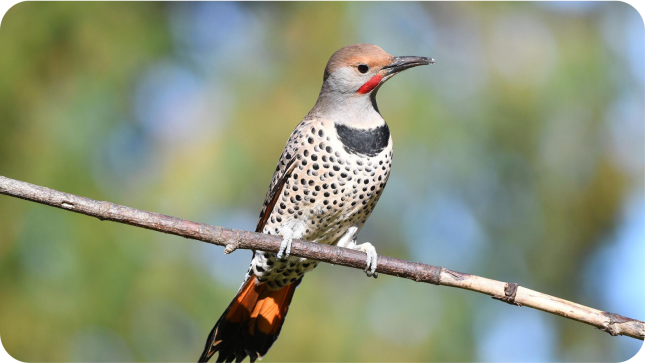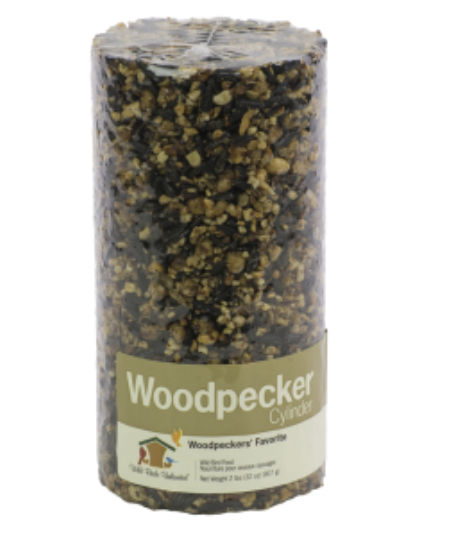
Attracting Woodpeckers - The Toughest Birds at Your Feeders
Woodpeckers are hard-headed. It comes with the territory.
When excavating, woodpeckers can strike a tree at speeds up to 15 mph. This is enough force to create brain damage in most other birds, and certainly in our human brain. But due to a number of adaptations, woodpeckers thrive on this heavy-hitting.
Woodpeckers' skulls are incredibly strong, yet lightweight, due to a reinforcing meshwork of bony support struts. This skull structure moderates the impact of the blows while transmitting the force away from the brain.
With all that pounding, why doesn’t a woodpecker’s bill wear down to a dull nub? It does wear down, however, special cells at the tip of the bill constantly replace the lost material, keeping the bill strong and sharp.
Woodpeckers' tails are as tough as their bills. Woodpeckers’ pointed tail feathers are especially strong and rigid, and their tail bones, lower vertebrae and the tail’s supporting muscles are very large in comparison to other birds.
These modifications allow a woodpecker's tail to serve as a sturdy prop that supports its weight while clinging to trees. This behavior and many other woodpecker adaptations can be witnessed in your yard. Woodpeckers can easily be attracted to feeders filled with suet and no-melt dough, especially varieties containing nuts. Simply offer these foods in a WBU Tail Prop feeder, and you can get an up-close and personal look at some of the toughest guys in the neighborhood.
Woodpecker Drumming
Many novice birders and non-birders mistakenly assume that woodpecker drumming is related to feeding and that woodpeckers may even eat the wood or sawdust they peck. In fact, while some woodpeckers may use drumming to help dislodge insects to eat or to drill holes to get at sap or burrowing insects, drumming is most often unrelated to eating. Instead, drumming is a method of communication, typically used to advertise a territory or attract a mate. In some cases, vigorous drumming also warns off intruders or scares away potential predators, especially if the bird is drumming on a loud, resonant object. While woodpeckers will use their bills as tools when feeding, they do so by prying insects out of wood rather than just hitting the wood, and no woodpeckers actually eat wood.
Woodpeckers of New Mexico
Pictured above is the Northern Flicker. Woodpeckers found in New Mexico include Acorn, Downy, Gila, Hairy, Ladder-backed, Lewis’s, Northern Flicker, Red-bellied, Red-headed, Red-naped Sapsucker, Williamson’s sapsucker and Yellow-bellied sapsucker.
Foods to Attract Woodpeckers
Depending on the season, a woodpecker may eat several different things. The exact foods preferred by each species vary, but the most popular woodpecker foods include: insects, tree sap, nuts, seeds, berries, and flower nectar.
Downy Woodpeckers are the most likely woodpecker species to visit a backyard bird feeder. They prefer suet feeders but are also fond of black oil sunflower seeds, millet, and peanuts. Other woodpeckers may come for mealworms offered at feeding stations; they have also been observed eating suet, nuts, and black oil sunflower seeds.
And, of course, like all backyard birds, they will love your bird bath!
Our Woodpecker Cylinder is a Woodpecker Magnet!
Woodpecker Cylinder
Made of tree nuts, black oil sunflower, and Bark Butter® Bits, our Woodpecker cylinder is perfect for attracting nut-eating birds, especially woodpeckers, nuthatches and chickadees.
Woodpeckers: Nature's Original Tree Huggers
Woodpeckers are some of the most loyal birds to attract to your bird feeders. In this podcast by Wild Birds Unlimited, hosts John Schaust and Brian Cunningham talk about the many fascinating adaptations woodpeckers have for the life they live. They also share a fun activity you can do with your family and talk about the benefits of creating a Certified Wildlife Habitat in your own backyard.
Click here to listen to this episode.







